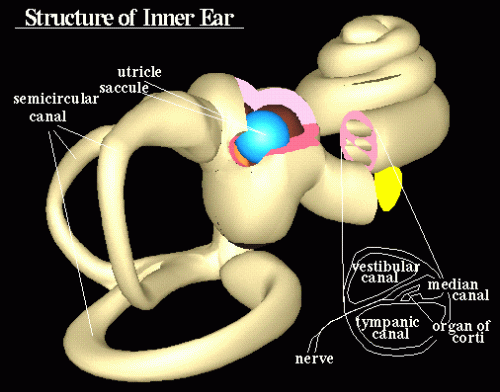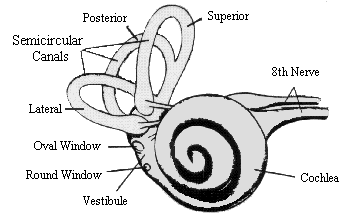Construction of a Computational Model of
the Cochlea
![]() Edward Givelberg (PI, Johns Hopkins University)
Edward Givelberg (PI, Johns Hopkins University)
![]() Julian Bunn (Center for Advanced Computing Research, Caltech,
Julian Bunn (Center for Advanced Computing Research, Caltech,
Project
Introduction
This project studies a component of the
inner ear, the cochlea, and its remarkable properties in
hearing.

(The source of this image is unknown - it was found on the Web sometime in the early 2000s - if you are the author/artist, please let me know.)
In the picture above, the cochlea is the
coiled, snail-like object that contains the vestibular, tympanic and median
canals. The following picture shows a different view, and includes the round
and oval windows.

Vibrations of the eardrum are transmitted to
the cochlea via a delicate set of bones which attach to the oval window.
The project is studying the main open problems
in auditory signal processing: the fine tuning of the cochlea (its ability to
differentiate nearby input sound frequencies), the nature of non-linear effects
in auditory signal processing and the significance of curvature in cochlear
geometry.
Cochlea
Model
The model incorporates a new shell theory
developed by Givelberg that applies techniques of differential geometry. The
shell theory was derived working solely from the Kirchhoff-Love hypothesis,
without the use of approximations or extraneous assumptions, such as the
moderate bending assumption, used in all previous shell theories.
The partial differential equations of this
shell model simulate the elastic response of the basilar membrane and together
with the Navier-Stokes equations provide a realistic description of the
macro-mechanics of the cochlea. This shell model has been incorporated into the
framework of the immersed boundary method resulting in a practical
algorithm.
This animated gif
shows the Cochlea model components, as they are built into the complete model,
and short sequence of simulated time steps.
Simulation
Results (2003)
Disclaimer: All results presented on this page are preliminary, and
subject to revision as we tune and correct the applicatio
We have made a special run of a 256x256x256 model, with a driving force at 8kHz, with 30ns time steps and 70000 time steps in total. This model uses a correct placement of the BM in relation to the shelf (the BM was previously positioned on the inner side, incorrectly) and a "tall" cochlea (previous experiments used a squashed cochlea so that the a fluid grid size of 128 could be used in the vertical dimension.
NEW An identical movie, but reduced image size (6MBytes) NEW
[This movie produced by Santiago Lombeyda]
Simulation Results (2002)
Disclaimer: All results
presented on this page are preliminary, and subject to revision as we tune and
correct the application.
Presently, an implementation of the cochlea
model is running on the HP Exemplar X and V class and SuperDome machines at
CACR. Simulations typically run for several days and comprise calculations of
tens of thousands of time steps. Each time step takes several seconds to
compute on the X and V class machines. On the SuperDome, using 32 processors,
only about 1 second is required per time step.
Initially, the model was calculated at a
resolution of 128x128x128 grid points, but now is being run at the desired
resolution of 256x256x128 grid points.
We are currently using the SuperDome in a dedicated
partition of 16 CPUs for our experiments.
This page shows plots of the displacement of the middle line on the Basilar Membrane
The following MPEG movies show the latest
(Novermber 2001) result using improved Oval window and other model parameters
Movies of the displacement of the centre of
the Basilar Membrane, as a function of time
Excitation (Link to MPEG)
|
Steps
|
Step Size (nanoSecs)
|
Equivalent duration of input (milliSecs)
|
Sine period (in Steps)
|
Envelope?
|
File Size (MBytes)
|
Thumbnail
|
15kHz Movie
|
0-27,000 |
30 |
0.8 |
2,222 |
Yes (@>15,000) |
10 |
|
10kHz Movie
|
0-20,000 |
30 |
0.6 |
3,333 |
Yes (@>10,000) |
11 |
|
5kHz Movie
|
0-30,000 |
30 |
0.9 |
6,667 |
Yes (@>20,000) |
11 |
|
2kHz Movie
|
0-40,000 |
30 |
1.2 |
16,667 |
No |
18 |
|
2kHz Movie
|
40,000-70,000 |
30 |
0.9 |
16,667 |
No |
14 |
|
2kHz Movie
|
70,000-100,000 |
30 |
0.9 |
16,667 |
Yes |
14 |
|
2kHz Movie
|
100,000-130,000 |
30 |
0.9 |
16,667 |
Yes |
14 |
|
Movies of the full 3D geometry of the
Basilar Membrane, Oval and Circular Windows, as a function of time
5kHz for
27000 40ns time steps
(12 MBytes)
Miscellaneous Movies
Response of the Oval
Window to an impulse force (23 MBytes)
Behaviour of the Oval and Round Windows where the Round Window is forced at a frequency of 10kHz. This movie is an animated GIF. The length of the movie corresponds to 8000 steps at 80 nanoseconds, i.e. about 6 cycles of the sinusoidal force. The Windows lie in a fluid grid of 256x256x128 points.In the movie, the Oval Window is on the right. (7 MBytes)
Earlier
Simulation Results (2001)
In the following older MPEG movies we show
the motion of the centre line of the Basilar membrane as a function of time,
for input excitation sinusoidal forces of 10kHz and 20kHz:
10 kHz (21 MBytes)
10 kHz 20,000 time
steps (9.5 MBytes)
20 kHz time
steps 20,000 to 23,000 (1.4 MBytes)
The following MPEG movies show a 3D model of
the Basilar membrane and semi-circular window displacements as a function of
time.
10kHz input, Unit
Force, 37,000 time steps, one frame every 100 steps (2.5 MBytes)
Straight
(unwrapped) Cochlea with impulse input, 2000 time steps, one frame per time
step, 40 ns time step (27 MBytes)
Earlier
Simulation Results (2000)
Screen
Shot of Application GUI
A Java3D-based tool
has been developed which allows the results from the cochlea simulation to be
viewed.
Publications
![]() "A Comprehensive
Three-Dimensional Model of the Cochlea" (PDF) [submitted]
"A Comprehensive
Three-Dimensional Model of the Cochlea" (PDF) [submitted]
![]() "Detailed Simulation of the Cochlea: Recent
Progress Using Large Shared Memory Parallel Computers: (PDF) presented at
the 2001 ASME
International Mechanical Engineering Congress and Exposition, and published
in the proceedings of that conference.
"Detailed Simulation of the Cochlea: Recent
Progress Using Large Shared Memory Parallel Computers: (PDF) presented at
the 2001 ASME
International Mechanical Engineering Congress and Exposition, and published
in the proceedings of that conference.
![]() "Modelling Elastic Shells Immersed in
Fluid" [submitted]
"Modelling Elastic Shells Immersed in
Fluid" [submitted]
Collaboration
Information
Please contact Ed Givelberg or Julian Bunn
(see below) if you have detailed questions on the research programme.
Edward Givelberg, Department of Mathematics,
University of Michigan email: givelber@eecs.berkeley.edu
Julian Bunn, Center for Advanced Computing
Research, California Institute of Technology: email: Julian@cacr.caltech.edu
Related Information



